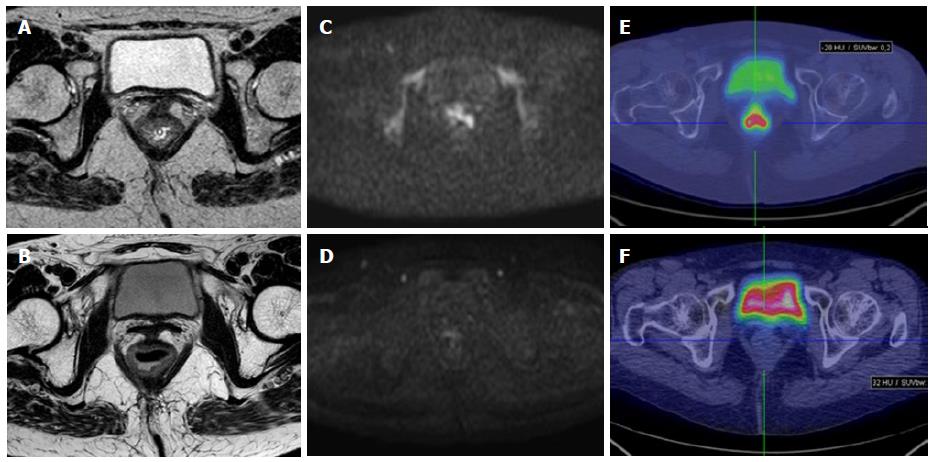Copyright
©The Author(s) 2015.
World J Radiol. Dec 28, 2015; 7(12): 509-520
Published online Dec 28, 2015. doi: 10.4329/wjr.v7.i12.509
Published online Dec 28, 2015. doi: 10.4329/wjr.v7.i12.509
Figure 2 A 63-year-old woman with pathologically proven cancer in low rectum.
It was difficult to evaluated correctly the response after CRT treatment by using only the T2 morphological information. After the additional reading of DWI images, the radiologist changed his evaluation and correctly classified the patient as responder. A: Pre-CRT T2-weighted axial MR image shows a ulcerative narrowing rectal neoplastic lesion from 11 to 3 o’clock position; B: Post-CRT T2-weighted axial MR image shows a residual homogeneous rectal wall thickening, isointense and not clearly definable as fibrotic tissue; C: Pre-CRT axial DWI image shows a focal hyperintense area in the corresponding site of rectal mass (ADC: 0.84 × 10-3 mm2/s); D: Post-CRT axial DWI shows no residual hyperintense signal in the corresponding site of rectal wall (ADC: 1.39 × 10-3 mm²/s); E: Pre-CRT axial pelvic scan of PET/CT examination image demonstrated a significant focal radiotracer uptake in correspondence of rectal mass (SUVmax: 9.3); F: Post-CRT axial pelvic scan of PET/CT examination image shows no significant uptake (SUVmax: 2.6). CRT: Chemoradiation treatment; DWI: Diffusion weighted imaging; ADC: Apparent diffusion coefficient; SUV: Standardized uptake value.
- Citation: Ippolito D, Fior D, Trattenero C, Ponti ED, Drago S, Guerra L, Franzesi CT, Sironi S. Combined value of apparent diffusion coefficient-standardized uptake value max in evaluation of post-treated locally advanced rectal cancer. World J Radiol 2015; 7(12): 509-520
- URL: https://www.wjgnet.com/1949-8470/full/v7/i12/509.htm
- DOI: https://dx.doi.org/10.4329/wjr.v7.i12.509









